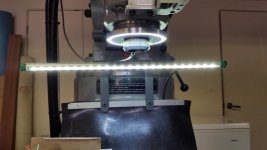Randalthor
Cast Iron
- Joined
- Mar 7, 2018
- Location
- Kansas City
I ended up buying a single phase V1000 drive for my 2J 1-1/2 Bridgeport mill.
CIMR-VUBA0010FAA - Yaskawa - AC Drives | Galco Industrial Electronics
I'm new to VFD's but have read the quick start manual (200+ pages).
https://www.galco.com/techdoc/yask/v1000_qs.pdf
I have some questions please, for anyone familiar with these drives.
1. I assume I want the control mode as Open Loop Vector, instead of V/f for a Bridgeport mill?
2. How fast can I safely stop the motor without any damage to the motor/head. My understanding is that there is a built in braking feature on this VFD. Of course the mill has a mechanical brake built in the head, but if I can stop the motor with the braking feature of the VFD, that would be a nice feature. I just don't how fast one can safely stop it over and over, without damage.
3. At the end of the manual (page 201) it suggests a 50A input fuse for this drive. This seems ridiculous to me, as the wire recommended is #12, plus the drive doesn't pull anywhere near 50 amps. I'm sure I'm misunderstanding something. Can someone please clarify?
I'm sure I'll have more questions as I move forward, but any help on any of these questions would be appreciated.
CIMR-VUBA0010FAA - Yaskawa - AC Drives | Galco Industrial Electronics
I'm new to VFD's but have read the quick start manual (200+ pages).
https://www.galco.com/techdoc/yask/v1000_qs.pdf
I have some questions please, for anyone familiar with these drives.
1. I assume I want the control mode as Open Loop Vector, instead of V/f for a Bridgeport mill?
2. How fast can I safely stop the motor without any damage to the motor/head. My understanding is that there is a built in braking feature on this VFD. Of course the mill has a mechanical brake built in the head, but if I can stop the motor with the braking feature of the VFD, that would be a nice feature. I just don't how fast one can safely stop it over and over, without damage.
3. At the end of the manual (page 201) it suggests a 50A input fuse for this drive. This seems ridiculous to me, as the wire recommended is #12, plus the drive doesn't pull anywhere near 50 amps. I'm sure I'm misunderstanding something. Can someone please clarify?
I'm sure I'll have more questions as I move forward, but any help on any of these questions would be appreciated.


![KIMG0934[1].jpg KIMG0934[1].jpg](https://www.practicalmachinist.com/forum/data/attachments/192/192433-691f709f7df5192fe56561d10bfe8eed.jpg)
